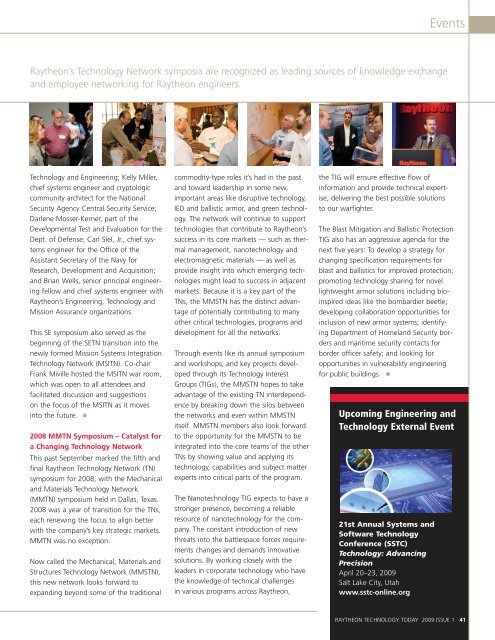2009 Issue 1 - Raytheon
2009 Issue 1 - Raytheon
2009 Issue 1 - Raytheon
You also want an ePaper? Increase the reach of your titles
YUMPU automatically turns print PDFs into web optimized ePapers that Google loves.
<strong>Raytheon</strong>’s Technology Network symposia are recognized as leading sources of knowledge exchange<br />
and employee networking for <strong>Raytheon</strong> engineers.<br />
Technology and Engineering; Kelly Miller,<br />
chief systems engineer and cryptologic<br />
community architect for the National<br />
Security Agency Central Security Service;<br />
Darlene Mosser-Kerner, part of the<br />
Developmental Test and Evaluation for the<br />
Dept. of Defense; Carl Siel, Jr., chief systems<br />
engineer for the Office of the<br />
Assistant Secretary of the Navy for<br />
Research, Development and Acquisition;<br />
and Brian Wells, senior principal engineering<br />
fellow and chief systems engineer with<br />
<strong>Raytheon</strong>’s Engineering, Technology and<br />
Mission Assurance organizations.<br />
This SE symposium also served as the<br />
beginning of the SETN transition into the<br />
newly formed Mission Systems Integration<br />
Technology Network (MSITN). Co-chair<br />
Frank Miville hosted the MSITN war room,<br />
which was open to all attendees and<br />
facilitated discussion and suggestions<br />
on the focus of the MSITN as it moves<br />
into the future.<br />
2008 MMTN Symposium – Catalyst for<br />
a Changing Technology Network<br />
This past September marked the fifth and<br />
final <strong>Raytheon</strong> Technology Network (TN)<br />
symposium for 2008, with the Mechanical<br />
and Materials Technology Network<br />
(MMTN) symposium held in Dallas, Texas.<br />
2008 was a year of transition for the TNs,<br />
each renewing the focus to align better<br />
with the company’s key strategic markets.<br />
MMTN was no exception.<br />
Now called the Mechanical, Materials and<br />
Structures Technology Network (MMSTN),<br />
this new network looks forward to<br />
expanding beyond some of the traditional<br />
commodity-type roles it’s had in the past<br />
and toward leadership in some new,<br />
important areas like disruptive technology,<br />
IED and ballistic armor, and green technology.<br />
The network will continue to support<br />
technologies that contribute to <strong>Raytheon</strong>’s<br />
success in its core markets — such as thermal<br />
management, nanotechnology and<br />
electromagnetic materials — as well as<br />
provide insight into which emerging technologies<br />
might lead to success in adjacent<br />
markets. Because it is a key part of the<br />
TNs, the MMSTN has the distinct advantage<br />
of potentially contributing to many<br />
other critical technologies, programs and<br />
development for all the networks.<br />
Through events like its annual symposium<br />
and workshops, and key projects developed<br />
through its Technology Interest<br />
Groups (TIGs), the MMSTN hopes to take<br />
advantage of the existing TN interdependence<br />
by breaking down the silos between<br />
the networks and even within MMSTN<br />
itself. MMSTN members also look forward<br />
to the opportunity for the MMSTN to be<br />
integrated into the core teams of the other<br />
TNs by showing value and applying its<br />
technology, capabilities and subject matter<br />
experts into critical parts of the program.<br />
The Nanotechnology TIG expects to have a<br />
stronger presence, becoming a reliable<br />
resource of nanotechnology for the company.<br />
The constant introduction of new<br />
threats into the battlespace forces requirements<br />
changes and demands innovative<br />
solutions. By working closely with the<br />
leaders in corporate technology who have<br />
the knowledge of technical challenges<br />
in various programs across <strong>Raytheon</strong>,<br />
the TIG will ensure effective flow of<br />
information and provide technical expertise,<br />
delivering the best possible solutions<br />
to our warfighter.<br />
The Blast Mitigation and Ballistic Protection<br />
TIG also has an aggressive agenda for the<br />
next five years: To develop a strategy for<br />
changing specification requirements for<br />
blast and ballistics for improved protection;<br />
promoting technology sharing for novel<br />
lightweight armor solutions including bioinspired<br />
ideas like the bombardier beetle;<br />
developing collaboration opportunities for<br />
inclusion of new armor systems; identifying<br />
Department of Homeland Security borders<br />
and maritime security contacts for<br />
border officer safety; and looking for<br />
opportunities in vulnerability engineering<br />
for public buildings.<br />
Upcoming Engineering and<br />
Technology External Event<br />
21st Annual Systems and<br />
Software Technology<br />
Conference (SSTC)<br />
Technology: Advancing<br />
Precision<br />
April 20–23, <strong>2009</strong><br />
Salt Lake City, Utah<br />
www.sstc-online.org<br />
Events<br />
RAYTHEON TECHNOLOGY TODAY <strong>2009</strong> ISSUE 1 41

















